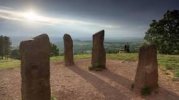Re Barr Beacon, the Aldridge History website says this....
The name Barr Beacon was first referred to as such in documents of the 17th century, although the name Barr is almost certainly derived from the Celtic “barra”, meaning summit. Early antiquarians thought this to be a centre for Druidic ceremonies, a belief no longer held. As a beacon there a possibility that one was fired there as a warning of the approach of the Spanish Armada. Until 1799 the land lying to the east was rough common land, and earlier, tree-covered as part of the Royal Forest of Cannock Chase. The summit was probably early-on cleared of trees making it well suited as a site for a beacon. When arms were granted to Thomas Scott of Great Barr before 1663, the crest was a black beacon flaming, with a red ladder. This was later adopted by Aldridge Urban District Council as its unofficial badge.


